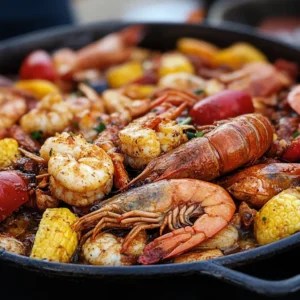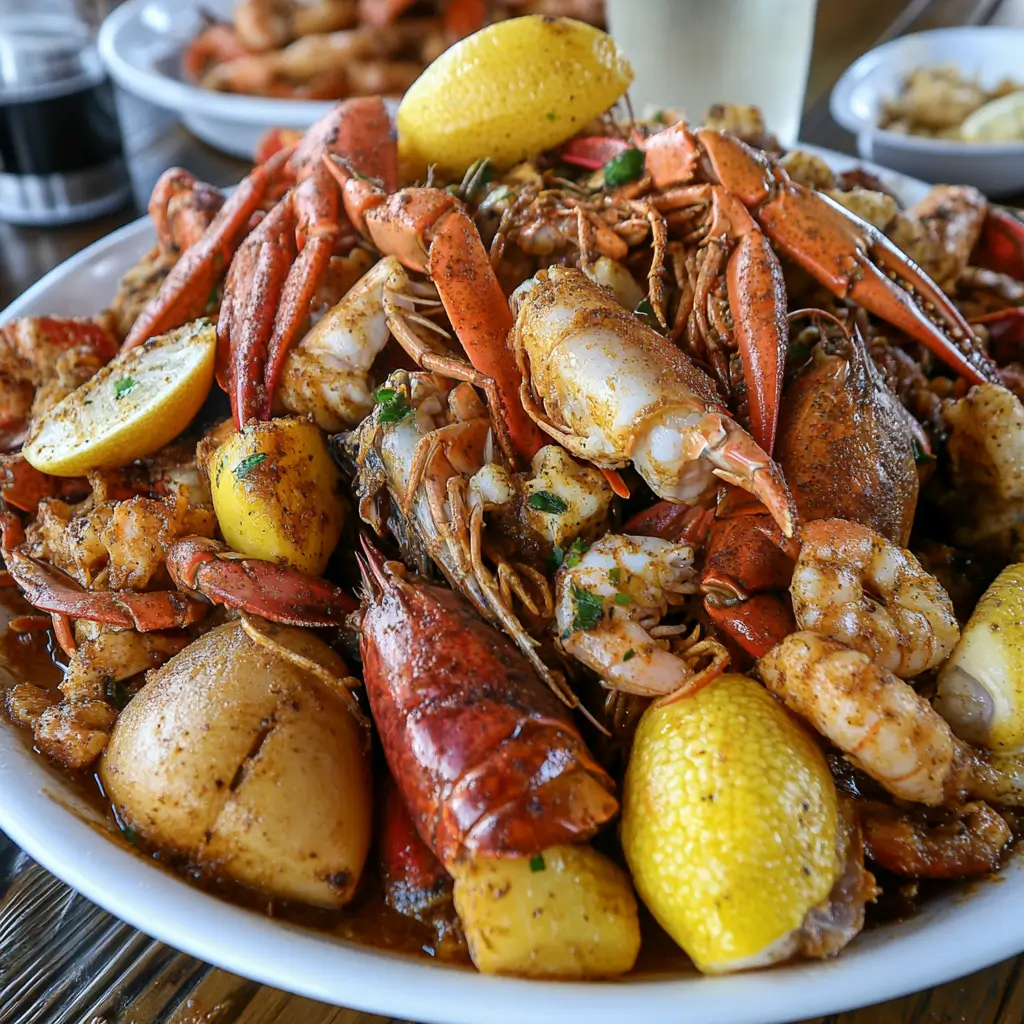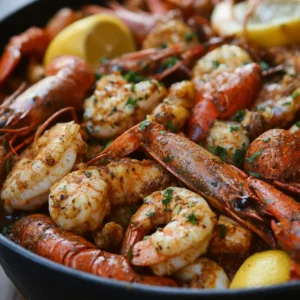Is Seafood Boil Cajun or Creole? This is a question many food enthusiasts ask when exploring Louisiana cuisine. A seafood boil can be either Cajun or Creole, depending on the ingredients, seasonings, and cooking techniques used. Both styles are rooted in Louisiana’s culinary traditions but have distinct characteristics.
Cajun or Creole Boil: Which Style Defines Seafood Tradition?
Seafood boils are iconic gatherings where friends and family come together to enjoy freshly boiled seafood, seasoned to perfection, and often spread out over a newspaper-covered table. These meals are synonymous with the Gulf Coast, particularly Louisiana, where seafood is abundant. The tradition has since spread globally, but its roots remain firmly planted in the culinary traditions of the American South.
Seafood Boil: Cajun or Creole? A Deep Dive into Flavor and Tradition
Key Characteristics of Cajun Cooking
Cajun cuisine is rustic and deeply rooted in the resourcefulness of Acadian settlers who adapted to life in the swamps of Louisiana. Key features include:
- Spices: Heavy use of cayenne, paprika, and garlic.
- Ingredients: Simple and hearty, focusing on rice, smoked meats, and seafood.
- Techniques: One-pot cooking methods like stews and gumbos.
Historical Roots
The Acadians, French colonists who were exiled from Canada during the 18th century, eventually settled in Louisiana, bringing with them a rich culinary heritage deeply rooted in French traditions. Once in Louisiana, they began adapting their recipes to incorporate the unique ingredients available in the region, such as crawfish, alligator, and a variety of spices. This blending of French techniques with local flavors and ingredients gave rise to Cajun cuisine, a style of cooking celebrated for its bold, hearty, and flavorful dishes. Over time, this culinary tradition evolved to include signature dishes like gumbo, jambalaya, and étouffée, which remain staples of Cajun cooking and a testament to the resilience and creativity of the Acadian people.
Popular Cajun Dishes
Classics like jambalaya, boudin, and gumbo showcase the depth of Cajun cuisine. Each dish reflects the use of bold seasonings and locally sourced ingredients.
Understanding Creole Cuisine
Key Characteristics of Creole Cooking
Creole cuisine is more refined and cosmopolitan, reflecting the cultural melting pot of New Orleans. Hallmarks include:
- Tomatoes: A defining ingredient in many dishes.
- French Influence: Use of roux, cream sauces, and elaborate techniques.
- Diversity: Incorporates African, Spanish, Caribbean, and Italian flavors.
Historical Influences
Creole cuisine developed in the urban centers of Louisiana, particularly in New Orleans, as a result of the diverse cultural influences that shaped the region. European settlers, including the French, Spanish, and Italians, brought their culinary techniques and ingredients, while enslaved Africans introduced rich flavors and cooking methods rooted in their heritage. Caribbean immigrants added bold spices and tropical ingredients, further enriching the cuisine. This fusion of cultures gave rise to a sophisticated culinary tradition characterized by its complex flavors and refined dishes, such as shrimp Creole, red beans and rice, and classic gumbo. Creole cuisine stands as a vibrant testament to the cultural diversity and history of Louisiana.
Popular Creole Dishes
Iconic dishes such as shrimp Creole, étouffée, and red beans and rice showcase the rich fusion of cultures that define Creole cuisine. These dishes highlight a reliance on bold, vibrant spices and flavorful sauces, reflecting the culinary influences of French, Spanish, African, and Caribbean traditions. Each recipe tells a story of cultural blending, with ingredients and techniques coming together to create meals that are both hearty and sophisticated, embodying the unique heritage of Louisiana’s Creole community.
The History of Seafood Boils
Seafood boils trace their origins to the abundance of seafood in the Gulf Coast and the communal nature of Southern culture. This tradition combines:
- Immigrant Influences: French, Spanish, and African immigrants shaped the flavor profiles and cooking methods.
- Regional Variations: From the Louisiana crawfish boil to the Carolina low-country boil, these meals vary widely across the South.
The seafood boil has long been a cherished centerpiece of community gatherings, festivals, and celebrations, bringing people together over shared meals. Its communal nature encourages connection and camaraderie, as friends and family gather around to enjoy a feast of freshly cooked seafood, often paired with corn, potatoes, and flavorful spices. This beloved tradition continues to unite communities, celebrating both the joy of togetherness and the rich culinary heritage it represents.
The Cajun Influence on Seafood Boils
Cajun seafood boils are known for their intense flavors and simplicity. Signature elements include:
- Seasoning Blends: Packed with cayenne, garlic, onion powder, and paprika.
- Ingredients: Crawfish, shrimp, corn, potatoes, and sausage are staples.
- Cooking Techniques: Boiling large quantities in a seasoned broth is the hallmark of Cajun boils.
The Creole Influence on Seafood Boils
Creole seafood boils incorporate elements that elevate the dish with added complexity. Key features include:
- Tomato-Based Broths: Creole boils often include tomato or wine bases.
- Herbs and Aromatics: Thyme, parsley, and celery add depth.
- Broader Ingredient Range: Crab, oysters, and even mussels might find their way into a Creole boil.
The Creole approach to cooking reflects its urban sophistication, seamlessly blending culinary techniques and traditions from French and Caribbean cuisines. This fusion results in dishes that are refined, flavorful, and deeply rooted in the rich cultural diversity of Creole communities, particularly in cities like New Orleans.
Key Differences Between Cajun and Creole Styles
Understanding the distinctions between Cajun and Creole cuisines helps clarify their roles in seafood boils. Key differences include:
- Ingredients: Cajun cuisine avoids tomatoes, while Creole dishes often use them.
- Techniques: Cajun boils are more rustic, while Creole versions are refined.
- Cultural Roots: Cajun cooking stems from rural traditions, while Creole cuisine is shaped by urban influences.
Similarities Between Cajun and Creole Cuisines
Despite their differences, Cajun and Creole cuisines share significant overlaps:
- Use of Local Ingredients: Both cuisines rely heavily on Gulf Coast seafood.
- Bold Flavors: Spices and herbs are integral to both styles.
- Community Focus: Meals are designed to bring people together.
These shared elements make it clear why seafood boils often serve as a perfect representation of both culinary traditions. The blending of bold Cajun spices with the refined flavors of Creole cooking creates a harmonious dish that embodies the rich cultural heritage of the region.
The Role of Seafood in Both Cuisines
Seafood is a cornerstone of both Cajun and Creole cooking. Louisiana’s proximity to the Gulf provides an abundance of shrimp, crawfish, crab, and fish, which feature prominently in:
- Cajun Dishes: Crawfish étouffée, shrimp gumbo.
- Creole Dishes: Seafood jambalaya, shrimp Creole.
The use of fresh, local seafood deeply connects both cuisines to the land and waters of Louisiana. This emphasis on regional ingredients not only highlights the natural abundance of the area but also reinforces the strong cultural and culinary ties to its unique environment.
Modern Interpretations of Seafood Boils
Today, seafood boils have transcended their Southern roots, evolving into a global phenomenon. Key trends include:
- Fusion Cuisine: Asian-Cajun seafood boils, popular in cities like Houston, blend traditional techniques with flavors like garlic butter and chili oil.
- Accessibility: Pre-packaged boil kits and restaurant chains make seafood boils accessible worldwide.
- Health-Conscious Options: Modern boils include gluten-free, low-sodium, and vegetarian adaptations.
These innovations help seafood boils stay relevant and cherished by new generations, blending tradition with modern twists to keep the experience fresh and exciting. By adapting to contemporary tastes while preserving their cultural roots, seafood boils continue to bring people together and celebrate the rich culinary heritage they represent.
Cooking Techniques in Seafood Boils
A great seafood boil requires attention to technique:
- The Boiling Process: Seafood is boiled in large pots with a heavily seasoned broth.
- Seasoning Timing: Adding spices at the right moment ensures even flavor distribution.
- Layering Ingredients: Vegetables and seafood are added sequentially based on cooking times.
The result is a deliciously cooked, flavorful feast that delights the senses and brings people together to enjoy a memorable meal.
Common Ingredients in Seafood Boils
Seafood boils showcase simple yet flavorful ingredients:
- Seafood: Crawfish, shrimp, crab, and clams.
- Vegetables: Corn, potatoes, and onions.
- Seasonings: Bay leaves, Old Bay, cayenne pepper, and garlic.
- Sides: Bread, dipping sauces, and coleslaw.
These ingredients showcase the perfect balance between bold, vibrant spices and fresh, locally sourced produce, creating dishes that are both flavorful and deeply rooted in their regional heritage.
The Social Aspect of Seafood Boils
Seafood boils are more than meals—they’re celebrations. These events foster:
- Community Bonding: Friends and family gather around shared tables.
- Tradition: From crawfish festivals to neighborhood boils, these events are steeped in cultural significance.
- Casual Dining: The informal nature encourages fun and connection.
Seafood boils truly capture the essence of communal dining, uniting people around a shared table to enjoy a flavorful and hands-on meal. This cherished tradition celebrates connection, togetherness, and the rich culinary heritage it represents, making every gathering memorable.

FAQs About Seafood Boils: Cajun or Creole?
1. Is seafood boil a traditional Cajun or Creole dish?
Seafood boils are influenced by both Cajun and Creole cuisines. Cajun boils are known for their rustic simplicity and heavy seasoning, while Creole boils may include a more refined flavor profile with ingredients like tomatoes and aromatic herbs. Depending on the preparation style, a seafood boil can reflect either tradition or even a blend of both.
2. What makes a seafood boil spicy?
The heat in a seafood boil comes from the seasoning blend, which often includes cayenne pepper, paprika, and crushed red pepper. Cajun boils, in particular, are known for their bold, spicy flavor. Adjusting the amount of these spices can help control the heat level to suit personal preferences.
3. Can seafood boils be adapted for vegetarians?
Yes, seafood boils can be adapted for vegetarians by replacing seafood with vegetables like mushrooms, artichokes, zucchini, and cauliflower. Vegetarian sausages can also be added, and the broth can be seasoned with traditional spices to maintain the dish’s bold flavor.
4. What are the best beverages to pair with a seafood boil?
Popular drink pairings for seafood boils include:
- Beer: Light lagers and pilsners are an excellent pairing for seafood boils, as they complement the spices without overpowering the dish’s bold flavors. Their crisp and refreshing profiles enhance the meal, making them a popular choice for gatherings.
- White Wine: Crisp white wines such as Sauvignon Blanc or Chardonnay are perfect companions for seafood boils, as they balance the richness of the seafood with their bright, refreshing acidity. Their flavors enhance the meal without overpowering its delicate nuances.
- Non-Alcoholic Options: Sweet tea, lemonade, or citrus-infused water are excellent beverage choices to pair with the bold flavors of a seafood boil. Their refreshing and slightly sweet profiles complement the spices and provide a perfect contrast to the richness of the dish.
5. How do you store leftovers from a seafood boil?
Leftovers should be refrigerated within two hours of serving. Place the seafood and other ingredients in airtight containers, separating the seafood from the vegetables if possible. Consume leftovers within 2–3 days, reheating them gently to maintain the texture and flavor.
6. What’s the difference between a low-country boil and a Cajun boil?
A low-country boil, popular in the Carolinas and Georgia, typically features shrimp, corn, sausage, and potatoes, seasoned with Old Bay seasoning. A Cajun boil, on the other hand, uses crawfish, shrimp, and a spicier seasoning mix that includes cayenne, garlic, and paprika. The flavor profile of Cajun boils is generally bolder and spicier than that of low-country boils.
Conclusion: Cajun or Creole Boil—A Delicious Debate
Is seafood boil Cajun or Creole? The answer depends on the flavors and ingredients you prefer. Cajun boils are spicier and simpler, while Creole boils are tangier and more complex. Both are delicious ways to enjoy Louisiana’s rich culinary heritage.
Related article:


